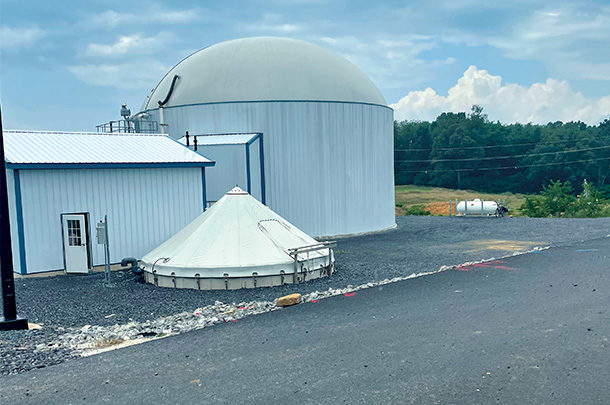Digesters are gaining popularity among dairy farms for several reasons. Not only do digesters reduce odor of manure and leave less of a residue, but they also help the condition of the soil. These are benefits for the farm as well as the environment. On July 21, Penn State University held its first Digester Day. As a part of the event, four members from the dairy industry in Pennsylvania sat down and discussed their experiences with digesters on their farms, and went through the pros, cons and surprises thus far.
- Jim Harbach has a 1,300-cow dairy about an hour from State College. In 2006, when their digester was put in, they were milking about 600 to 700 cows, and the digester was built for 1,000 cows. At that time, it was not balanced, but now that they are over that cow number, there’s extra gas being produced.
- Brett Reinford milks 800 cows. The farm’s first digester was installed in 2008. A second digester was built in 2019.
- Shawn Saylor is a Somerset County dairy farmer, milking 700 cows. Their digester was installed in 2007 and is working well for their operation, he said.
- Randall Swope is the facility coordinator of the animal science department at Penn State University. Swope aids in operating the solid manure stacked digester the university recently installed. Swope said, “The university’s main reason for installing the digester was to help in the wildlife management at the university-owned airport ground, which is surrounded by cropland. Manure from the digester leaves less of a residue than solid manure, therefore deterring birds from lingering around the air traffic.” Reducing the amount of manure-hauling traffic on Park Avenue – one of the main roads through the college campus – was another main objective. Currently, the digester is taking in manure from the dairy freestall barn, with plans to take in manure from the swine facility as well.
Is the biogas production a smooth process?
HARBACH: We have a food waste permit, but we have a hard time getting the digester to work with it. Having a digester is like having another kid – there is always something to be watching for.
REINFORD: My dad is passionate about this; we’ve found taking in food waste is OK, but consistent manure supply really helps this process work well.
SAYLOR: The digester is simple to look at if you have basic knowledge of it, but you can’t walk away from it, just like you can’t walk away from the cows. There have been some maintenance issues, but it is still profitable. Food waste has worked out well for us, but we do charge a fee. Gas production has gone up. Manure is a stabilizer, but you have to watch closely when putting in food waste.
SWOPE: The digester is still very new to us. To start up, manure is being used from the dairy, with around 350 animals contributing waste. There is also a sand separator. We are flaring gas at present. Some issues so far have just been electrical sensors, as this digester has a lot of technology on it.
Is there anything you wish you would have known in advance?
HARBACH: Do your homework before you start. Visit several digesters. The biggest issue we had was with utilities. We started with 600 cows with a digester built for 1,000 cows, so the engine wasn’t efficient at first, and now we are over 1,000 cows, so it might be time to upgrade.
REINFORD: There are a lot of pumps and mixers. Make sure the digester is engineered right. Our first one blew up. The engine was up top, and it blew the top right off. We then found it was three-quarters full of solids, so it needs to be cleaned out regularly, and mixed enough but not overmixed. A scrubber on the motor is a huge help.
SAYLOR: No one said anything about issues with the digesters when we were touring them before we built one. The biggest issues we’ve faced have been plugging, staying away from pipes and minimizing the distance material has to travel.
SWOPE: Maybe we shouldn’t have tried to accomplish too much and hired a manager to look at the project regularly, not just someone passing through daily.
How were you surprised with added value from the digester?
HARBACH: After having a digester for 15 years, and even if there was no electricity money, we would still build one again. Odor reduction was a big benefit, improvement in farm ground quality and the lack of odor of the manure after coming out of the digester were other big surprises. We also use the heat for the parlor floor and drying towels – this saves money and we have it designed to use every facet of energy.
REINFORD: Our sole purpose was to reduce odor; we wanted to help the community around us. At first, we didn’t think of selling to the grid. Three months after we built the digester, we started taking in food waste and charging a tipping fee. We also sell renewable energy credits, and we use the heat for heating water and the houses on the farm.
SAYLOR: The renewable energy credits were unexpected. Also, the reduction of odor saved us a lot of lawyer fees from complaining neighbors. In addition to no-tilling ground, the nutrient changes in the ground have been significantly better. We take in food waste with tipping fees and this pays for manure handling. Finally, we use the solids for bedding. It is not as good as sand, but still works well.
SWOPE: Odor reduction was a big positive. A sand separator for bedding and getting the sand out of the manure stream has made for better handling. Renewable energy credits were also a benefit, and there have been a lot of teaching, educational and research components as well.
How does your digester fit into your sustainability plan?
HARBACH: We have been no-tilling for 50 years and we don’t inject into the ground; rather we draghose manure. Off of our own data, we are getting all of the necessary nutrients this way. We also separate solids for bedding, which is recycling.
REINFORD: We made the digester part of our farm’s story of investment to become more sustainable and to shed a better light on dairy farming. It was also an economic benefit to the farm, as the university has done on-farm studies on a regular basis.
SWOPE: The digester feeds into the university grid, and we get credits.
What companies were involved with your project?
HARBACH: RCM Digesters designed ours, and Martin Construction Resource put the engine in.
REINFORD: We went all the way to the state of Washington to better understand the technology behind the digester. Martin Energy Group built both of ours; they are a reputable company. Ours is a complete mix circle with an insulated tarp on top.
SAYLOR: We did most of the work ourselves to pay out less. This worked well – just some minor issues to work through. As far as the equipment goes, we used a lot of commercial products; this will save down the road. The biggest issue is with corrosiveness. Keep the engine away from any copper sulfate to keep electronics safe. Ours doesn’t have many sensors – just the basic temperature one.
SWOPE: We used two main companies out of Pittsburgh. We also built a new freestall barn and concrete manure storage as part of this. Everything is still new and working well thus far.


.jpg?t=1687979285&width=640)




